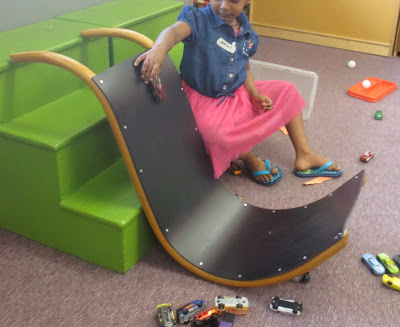I finally decided nobody was going to fix it so I was going to throw it out. However, when I looked at the pieces of wood, I wondered if I could make anything out of the curved pieces of wood. I was especially intrigued by the two handle pieces.
My initial idea was to make a curved ramp for the water table so when the children poured water down the ramp it would follow the curves of the apparatus and fly off the end. I detached the two curved handle pieces. I then used a utility knife to cut a black piece of 100 HDPE plastic so it measured 12" X 36." Because the plastic sheet was bendable, I was able to screw it onto the two curved handle pieces.
I left handles on one end so I could attach it to a base onto the water table.
When I got to school and tried it out, I was totally disappointed. When I poured water down the ramp, the falling water never gained enough force to overcome the curve up to fly off the end of the ramp. The water just pooled and rolled off the sides of the apparatus at the bottom of the curve. I was all set to chalk it up as a failure and bring it home to try to modify it.
When I showed it to my colleague, she was impressed with the appearance and the form of the apparatus. She suggested I put it somewhere else in the room for the children to explore using balls or cars. I decided to set it up on the green steps in my room with a bucket of cars. Instead of a rocking chair water ramp, I ended up with a rocking chair car ramp.
Here is what it looked like in action. Three boys were camped around the ramp. One of them was even sitting in between the handles in a comfortable position for launching his cars. The child in the blue shirt launched a car that jumped right into the bin at the end of the ramp. "Wow," he exclaimed. "It went right in." As the car traveled down the ramp and launched, his right leg kicked in unison with the movement of the car. He tried two more times, one time it crashed into another car, but that cleared the way for the third launch that flew over the bin. At the end of the video, the child in between the handles launched two cars simultaneously, both of which flew off to the side on the end.
Rocking chair car ramp from Thomas Bedard on Vimeo.
Since the rocking chair car ramp was not tied down, the children could move it around to their hearts' content. Two of the boys featured in the video above, climbed the stairs to sit on the window ledge so they could launch cars from a little higher elevation.
The arrow in the picture above points to the car that just flew off the ramp. The higher the elevation, the more dramatic was the the flight for the cars.
Three children even turned the rocking chair ramp on its head. They did that so they could see what would happen if they propelled the cars up the curved ramp.
Up the rocking chair car ramp from Thomas Bedard on Vimeo.
Silly me, I have no imagination. I thought cars could only go one way on the ramp: down.
One child even turned the whole ramp over and ran her cars on the underside of the ramp.
Instead of using the ramp for propelling cars, one child used it for transporting the cars in mass.
They also found out it worked well as a baby teeter-totter
Heck, it even worked well as a lounge chair. It was made from a chair, after all.
I was about to take this home when I saw that it did not worked as I had intended. I counted it as another one of those failed ideas for sensory table. Thanks to my colleague who could see it with fresh eyes, I left it in the room as a loose part for the children to explore. My intentions seem measly compared to the many and varied uses the children came up for this construction.
I am left with the question: How do we keep our "intentional" practice open to allow the children enough agency to discover the possibilities of a setup that can only be realized through their play? Sometimes we need fresh eyes. Thank you Lani for your fresh eyes.























